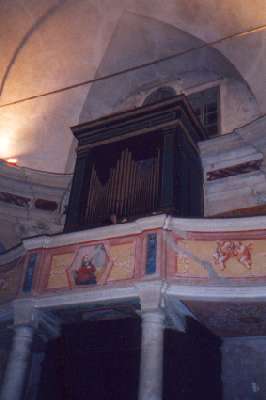church OF
SAINT gottardo
organ BUILT BY GlOSUE' agatI 1840 OPUS. 297

In wooden choir over the main entrance.
Flat prospectus to three spans of 29 reeds with mouthes to course discordant with the peaks and lip superior to mitre.
Boxwood and ebony keyboard of 50 notes with extension
Do-Fa5 short octave. Rudder bar of 8 notes with extension Do-Si.
Operated registers from connecting rods
at right of the keyboard.
Low principal
8' *
Sopranoes principal
8' *
Octave
*
Decimaquinta
*
Decimanona
*
Vigesimaseconda
*
Vigesimasesta
*
Vigesimanona
*
Sopranoes cornet
Low trumpets
Sopranoes trumpets
Flute VIII
*
Human voice
*
Chinese cornet
English horn
Piccolo
Low pedal
*
Accessories: Usignoli *; Drums*; Bells. Pedaletto for the Tiraripieno.
Sommiere teacher to be tight and a
sommiere for the reeds of basseria. Three bellowses operated by motor or ropes.
On the stamp paper
''Giosué Agati Fabbricante d'Organi costruirono l'anno 1840 in Pistoja, no297"
( The mark * announces the restored registers during the conservative intervention in the May 1996 from
the organ-builder B. Giribaldi)
NOTES
Torrazza has a big organ patrimony: the G.B.
Ciurlo organ ( 1778-79 ) one of the 7 organs of this author, in condition of particular authenticity, not having interventions that have modified the nature.
G.B. Ciurlo ( 1736-1811 ) descendant of the ancient
family of the Roccatagliata of Santa Margherita Ligure, his activity places among the 1775 and 1811 (
sited in Torre Paponi with the child Domenico) he said " the mad" as, of fact,
he became during the construction of the organ of S.Antonio to the harbor of Genoa.
The tools were bring away sea till the near
port and transported by mule till destination, there the tool was mounted by the organ-builder and of his assistants, in a box already built and decorated from
local artisans.
The
Agate family is instead among the greater producers organ of all the eight hundred Italian, and the tool of the church of
Saint Gottardo traces the characteristics of this epoch: numerous registers to imitation of orchestral tools and band, the use of the " mutations " in the stuffing to separate file the short and numerous rudder bar smaller effects ( drum,
usignoli, but even record details as the "chinese cornet" that is the bagpipe).
The Agate organs, besides the sonorous sturdiness, guaranteed even a
minor price in comparison with the Lombard organs, due to the transport by sea more economic and clear that by road,
even for numerous custom duties ( before the unity of Italia ), but even of a greater cost to cross the maritime alps.
Our ancestors cultivated a keen interest for the music, in fact, till the beginning of the century XX, in the principal
parties were paid local musicians ( often violinists or wind instruments ).
At the beginning of the eight hundred for this orchestras, the Giuseppe Barla priest composed an evening
and a mass, whose text are still preserved in file. We know that before the acquisition of the organ
of Saint George ( 1778 ) came rented for the parties a 'portativo' organ, i.e. fortified of bars and erases, as that used for
the statues in the processions, that made easy the transport.
Sources consult:
Parish file of Torrazza
M. Tarrini and G. Bretagna "Una dinastia..."
ed. Liguria
S. Rodi "Organi Roccatagliata e Ciurlo nel ponente
ligure " from "Atti del
convegno........." ed. Liguria.
A. Borzachiello "Note
ingaune" ed. Vetta- Seminario
